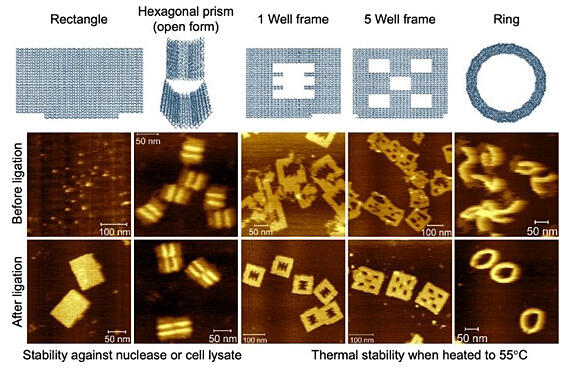A research group led by Professor Takashi Morii, Junior Associate Professor Arivazhagan Rajendran and Researcher Kirankumar Krishnamurthy of the Institute of Advanced Energy at Kyoto University announced the development of two techniques to reinforce any DNA origami created for nano-biomaterials. The research group succeeded in efficiently ligating staple nicks within the DNA origami with natural DNA binding, using either enzymatic reactions in a solvent containing dimethyl sulfoxide (DMSO) or chemical reactions involving cyanogen bromide (CNBr). They confirmed a significant improvement in the stability of the DNA origami under various conditions, such as high temperatures and in cell lysis solutions. The expansion of DNA origami applications is highly anticipated. The findings were published online in the journal Small Methods on September 21.

Provided by Kyoto University
DNA origami, a technique developed at the California Institute of Technology in 2006, allows DNA to fold and self-assemble into 2D and 3D nanostructures. By adding short complementary DNA strands to a circular single-stranded DNA template through heating and then slow cooling steps, it is possible to quantitatively design and fabricate DNA nanostructures in a straightforward manner. These structures hold promise for wide applications, such as for drug or vaccine delivery and virus suppression. However, their low stability has been a challenge. Although the stabilization of DNA nanostructures through chemical modifications has been reported, their functionality has been hindered. Stabilization of the nanostructure while maintaining integrity of the natural DNA is necessary to achieve its full functionality.
In this study, the research group examined whether the hundreds of staple nicks in the DNA origami were responsible for its low stability. They revealed that it was possible to efficiently ligate hundreds of gaps and staple nicks within the DNA origami through enzymatic reactions in a solvent containing DMSO or chemical reactions using CNBr.
Both methods were confirmed to be effective in stabilizing the 2D origami shapes. In particular, the ligation method through CNBr reactions proved effective for 3D origami shapes. Furthermore, this method significantly enhanced the stability of the DNA origami, even under conditions such as high temperatures or in cell lysis solutions, which are typically challenging for DNA origami structures.
An unexpected discovery was the significant increase in enzymatic ligation efficiency in the presence of DMSO. Not only does DMSO stabilize enzymes, but it also allows for the possibility of inducing structural changes in DNA that favor its orientation at reaction sites.
Professor Morii explained: "DNA nanomaterials, exemplified by DNA origami, can exhibit innovative performance in the development of highly reliable drug delivery systems, improved virus suppression strategies, and carbon-neutral bioenergy systems. Although DNA nanomaterials have a wide range of potential applications, they have been considered far from practical implementation in society due to their low stability. Our recent discovery reveals that by using chemically linked reagents instead of enzymes, efficient ligation reactions occur even in 3D DNA origami structures, leading to their stabilization. Our research not only demonstrates the significance of integrating chemistry, biology, and nanotechnology but also shows the potential of nano-biomaterials to advance innovative technologies in various fields, such as healthcare and materials science, for supporting a better society."
This research was undertaken as part of the JST CREST research project "Intracellular fate of extracellular fine particles and the control system" (JPMJCR18H5).
This article has been translated by JST with permission from The Science News Ltd. (https://sci-news.co.jp/). Unauthorized reproduction of the article and photographs is prohibited.




